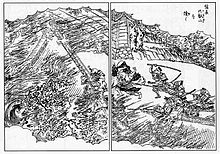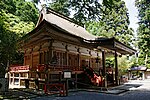Enryaku-ji
| Enryaku-ji | |
|---|---|
延暦寺 | |
Ōtsu, Shiga Prefecture | |
| Country | Japan |
| Architecture | |
| Founder | Saichō |
| Date established | 788 |
| Completed | 1642 (reconstruction) |
| Website | |
| www | |

Enryaku-ji (延暦寺, Enryaku-ji) is a
History
With the support of Emperor Kanmu, the Buddhist monk Saichō ordained a hundred disciples in 807. Maintaining a strict discipline on Mt. Hiei, his monks lived in seclusion for twelve years of study and meditation. After this period, the best students were retained in positions in the monastery and others graduated into positions in the government. At the peak of its power, Enryaku-ji was a huge complex of as many as 3,000 sub-temples and a powerful army of warrior monks (僧兵, sōhei). In the tenth century, succession disputes broke out between Tendai monks of the line of Ennin and Enchin. These disputes resulted in opposing Tendai centers at Enryaku-ji and at Mii-dera, known respectively as the Mountain Order (山門, sanmon) and the Temple Order (寺門, jimon). Warrior monks were used to settle the disputes, and Tendai leaders began to hire mercenary armies who threatened rivals and even marched on the capital to enforce monastic demands.
As part of a program to remove all potential rivals and unite the country, warlord
Today, most of Enryaku-ji's buildings are clustered in three areas: Tō-dō (東塔, "East Pagoda"), Sai-tō (西塔, "West Pagoda"), and Yokokawa (横川). The monastery's most important buildings are concentrated in Tō-dō. Sai-tō is a 20-minute walk away, primarily downhill from Tō-dō, and also features several important buildings. Yokokawa is more isolated and less visited, about a 1:30 walk, and is most easily reached by bus, which connects the three complexes and other locations on the mountain.
Collusion with organized crime
On April 4, 2006, Enryaku-ji performed a ceremony for former leaders of Yamaguchi-gumi, by far the largest yakuza organization in Japan.[4]
Because such temple ceremonies have been used for Yamaguchi-gumi fund-raising and demonstrations of power, the
After reports in the
Gallery
-
Great Lecture Hall (大講堂, Daikō-dō)
-
Hall of Initiation (灌頂堂, Kanjō-dō)
-
Monju-rō gate (文殊楼, Monju-rō)
-
Bell Tower (鐘楼, Shōrō)
-
East Pagoda (東塔, Tō-tō)
-
AmidaHall (阿弥陀堂, Amida-dō)
-
Ordination Hall (戒壇院, Kaidan-in)
-
Yokawa Main Hall (横川中堂, Yokawa-chūdō)
See also
- Glossary of Japanese Buddhism (for an explanation of terms concerning Japanese Buddhism, Japanese Buddhist art, and Japanese Buddhist temple architecture)
- Guoqing Temple
- Historic Monuments of Ancient Kyoto (Kyoto, Uji and Otsu Cities)
- List of Buddhist temples in Kyoto
- List of National Treasures of Japan (ancient documents)
- List of National Treasures of Japan (crafts-others)
- List of National Treasures of Japan (temples)
- List of National Treasures of Japan (writings)
- Tourism in Japan
Notes
- ^ Ponsonby-Fane, Richard. (1956). Kyoto: The Old Capital of Japan, 794-1869, p. 111.
- ISBN 0804705259.
- ^ "瑠璃堂". www.kagemarukun.fromc.jp.
- ^ Enryakuji temple leaders resign over yakuza service Archived 2012-04-24 at the Wayback Machine
- ^ 天台宗. "天台の主張 記事 (7)". tendai.or.jp.
References
- Ponsonby-Fane, Richard Arthur Brabazon. (1956). Kyoto: The Old Capital of Japan, 794–1869. Kyoto: The Ponsonby Memorial Society. [ISBN missing]










